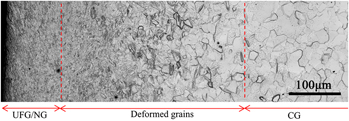Crossref Citations
This article has been cited by the following publications. This list is generated based on data provided by
Crossref.
YIN, Yan-fei
XU, Wei
SUN, Qiao-yan
XIAO, Lin
and
SUN, Jun
2015.
Deformation and fracture behavior of commercially pure titanium with gradient nano-to-micron-grained surface layer.
Transactions of Nonferrous Metals Society of China,
Vol. 25,
Issue. 3,
p.
738.
Liu, Y.G.
Li, M.Q.
and
Liu, H.J.
2016.
Surface nanocrystallization and gradient structure developed in the bulk TC4 alloy processed by shot peening.
Journal of Alloys and Compounds,
Vol. 685,
Issue. ,
p.
186.
Wang, Qi
Sun, Qiaoyan
Xiao, Lin
and
Sun, Jun
2016.
Effect of Surface Nanocrystallization on Fatigue Behavior of Pure Titanium.
Journal of Materials Engineering and Performance,
Vol. 25,
Issue. 1,
p.
241.
Wang, Lifei
Zhang, Hua
Huang, Guangsheng
Cao, Miao
Cao, Xiaoqing
Mostaed, Ehsan
and
Vedani, Maurizio
2016.
Formability and anisotropy of the mechanical properties in commercially pure titanium after various routes normal and different speed rolling.
Journal of Materials Research,
Vol. 31,
Issue. 21,
p.
3372.
Kolobov, Yu. R.
Manokhin, S. S.
Kolobova, A. Yu.
Kudymova, Yu. E.
Betekhtin, V. I.
Golyshev, A. A.
Molodets, A. M.
and
Andrievskii, R. A.
2016.
Shock-wave-induced grain refinement and phase state modification in coarse-grained and nanocrystalline titanium.
Technical Physics Letters,
Vol. 42,
Issue. 9,
p.
959.
Andrievski, Rostislav A.
and
Khatchoyan, Arsen V.
2016.
Nanomaterials in Extreme Environments.
Vol. 230,
Issue. ,
p.
55.
Wang, Qi
Sun, Qiaoyan
Xiao, Lin
and
Sun, Jun
2016.
Torsion fatigue behavior of pure titanium with a gradient nanostructured surface layer.
Materials Science and Engineering: A,
Vol. 649,
Issue. ,
p.
359.
Andrievski, Rostislav A.
and
Khatchoyan, Arsen V.
2016.
Nanomaterials in Extreme Environments.
Vol. 230,
Issue. ,
p.
7.
Wang, Q.
Xin, C.
Sun, Q.
Xiao, L.
and
Sun, J.
2017.
Biaxial tension-torsion fatigue behavior of gradient nano-grained pure titanium fabricated by surface nanocrystallization.
Materials Science and Engineering: A,
Vol. 702,
Issue. ,
p.
125.
Wang, Peng
Yang, Xinhua
and
Peng, Di
2017.
Molecular dynamics investigation of the grain boundary migration hysteresis of nanocrystalline Ni under cyclic shear loading.
Modelling and Simulation in Materials Science and Engineering,
Vol. 25,
Issue. 2,
p.
025006.
Betekhtin, V. I.
Kadomtsev, A. G.
and
Narykova, M. V.
2017.
Effect of the allotropic transition in titanium on its interatomic interaction energy.
Technical Physics Letters,
Vol. 43,
Issue. 8,
p.
708.
Fronczek, D.M.
Saksl, K.
Chulist, R.
Michalik, S.
Wojewoda-Budka, J.
Sniezek, L.
Wachowski, M.
Torzewski, J.
Sulikova, M.
Sulova, K.
Lachova, A.
Fejercak, M.
Daisenberger, D.
Szulc, Z.
and
Kania, Z.
2018.
Residual stresses distribution, correlated with bending tests, within explosively welded Ti gr. 2/A1050 bimetals.
Materials Characterization,
Vol. 144,
Issue. ,
p.
461.
Ding, Jie
Li, Q.
Li, Jin
Xue, S.
Fan, Z.
Wang, H.
and
Zhang, X.
2018.
Mechanical behavior of structurally gradient nickel alloy.
Acta Materialia,
Vol. 149,
Issue. ,
p.
57.
Chae, Jong-Min
Lee, Keun-Oh
and
Amanov, Auezhan
2018.
Gradient Nanostructured Tantalum by Thermal-Mechanical Ultrasonic Impact Energy.
Materials,
Vol. 11,
Issue. 3,
p.
452.
Wang, Q.
Xin, C.
Sun, Q.
Xiao, L.
and
Sun, J.
2018.
Biaxial fatigue behavior of gradient structural purity titanium under in-phase and out-of-phase loading.
International Journal of Fatigue,
Vol. 116,
Issue. ,
p.
602.
Xin, Chao
Sun, Qiaoyan
Xiao, Lin
and
Sun, Jun
2018.
Biaxial fatigue property enhancement of gradient ultra-fine-grained Zircaloy-4 prepared by surface mechanical rolling treatment.
Journal of Materials Science,
Vol. 53,
Issue. 17,
p.
12492.
Liu, Y.G.
and
Li, M.Q.
2019.
The coordination behaviors of alpha and beta phases with different grain sizes in Ti-6Al-4V subjected to surface severe plastic deformation.
Materials Science and Engineering: A,
Vol. 745,
Issue. ,
p.
291.
Lee, Hak Hyeon
Yoon, Jae Ik
Park, Hyung Keun
and
Kim, Hyoung Seop
2019.
Unique microstructure and simultaneous enhancements of strength and ductility in gradient-microstructured Cu sheet produced by single-roll angular-rolling.
Acta Materialia,
Vol. 166,
Issue. ,
p.
638.
Huang, Z.W.
Yong, P.L.
Liang, N.N.
and
Li, Y.S.
2019.
Slip, twinning and twin-twin interaction in a gradient structured titanium.
Materials Characterization,
Vol. 149,
Issue. ,
p.
52.
Liu, Y.G.
and
Li, M.Q.
2019.
Structure response characteristics and surface nanocrystallization mechanism of alpha phase in Ti-6Al-4V subjected to high energy shot peening.
Journal of Alloys and Compounds,
Vol. 773,
Issue. ,
p.
860.

 $\overline 1$2} deformation twins together with a low fraction of {11
$\overline 1$2} deformation twins together with a low fraction of {11 $\overline 2$2} and {11
$\overline 2$2} and {11 $\overline 2$4} twins were identified. Based on the microstructural analysis, the grain refinement mechanisms with increasing strain are summarized as: (i) prior division by deformation twinning, (ii) refinement effect of subgrain boundaries resulting from the accumulation of high density of dislocation, and (iii) transformation effect from low angle grain boundaries to high angle grain boundaries. The results of tension tests also show that the titanium sample after SRT shows higher strength than the as-received titanium sample.
$\overline 2$4} twins were identified. Based on the microstructural analysis, the grain refinement mechanisms with increasing strain are summarized as: (i) prior division by deformation twinning, (ii) refinement effect of subgrain boundaries resulting from the accumulation of high density of dislocation, and (iii) transformation effect from low angle grain boundaries to high angle grain boundaries. The results of tension tests also show that the titanium sample after SRT shows higher strength than the as-received titanium sample.

